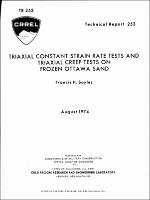Please use this identifier to cite or link to this item:
https://hdl.handle.net/11681/5618| Title: | Triaxial constant strain rate tests and triaxial creep tests on frozen Ottawa sand |
| Authors: | Sayles, Francis H. |
| Keywords: | Frozen sand Ice cores Compressive strength Creep Creep rate Creep tests Creep properties Frozen soils Frozen ground Permafrost Ice Soil tests Soils Strain tests |
| Publisher: | Cold Regions Research and Engineering Laboratory (U.S.) Engineer Research and Development Center (U.S.) |
| Series/Report no.: | Technical report (Cold Regions Research and Engineering Laboratory (U.S.)) ; 253. |
| Description: | Technical Report Abstract: Saturated frozen Ottawa sand cylinders and polycrystalline columnar ice were tested in the laboratory under triaxial compressive stress conditions using: 1) constant rate of axial strain, and 2) constant load, i.e. creep tests. The constant rate of axial strain tests were performed by applying axial strain rates in the range from 0.1 to 50% per minute and confining pressures from 0 to 1200 psi (84.4 kg/cm^2). The triaxial compression creep tests were conducted for time periods up to 3000 hr using a range of confining pressures from 0 to 800 psi (56 kg/cm^2) and deviator stresses from 37.5 to 1000 psi (2.6 to 70.3 kg/cm^2). The resulting stress-strain curves and Mohr envelopes for the constant rate of axial strain tests indicate that at rates of strain greater than about 0.02 per minute, the ice matrix fractures prior to the development of friction between the sand grains. At slower rates of applied strain, the friction between sand grains develops, presumably because ice has sufficient time to creep from between the sand grains. The relationship between the observed maximum deviator stress and the applied strain rate can be represented by an empirical expression for all the confining pressures tested. Results from the triaxial creep tests show that creep strength increases with confining pressure and axial creep strain is reduced by increasing the confining pressure. It is suggested that the long-term ultimate creep strength of saturated frozen sand is a function of the internal friction of the sand which could be determined through triaxial tests on freely drained unfrozen sand. |
| Rights: | Approved for public release; distribution is unlimited. |
| URI: | http://hdl.handle.net/11681/5618 |
| Appears in Collections: | Technical Report |
Files in This Item:
| File | Description | Size | Format | |
|---|---|---|---|---|
| CRREL-Technical-Report-253.pdf | 1.35 MB | Adobe PDF |  View/Open |